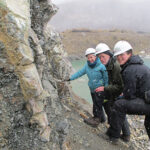By Holly Elliott, Camborne School of Mines, University of Exeter
Carbonatite and alkaline-silicate magmatic systems are highly evolved and form some of the strangest mineral assemblages and chemistry observed in igneous rocks. They are also the most important sources of rare earth elements (REE), which are especially important in hi-tech products and ‘green technologies’. China currently produces >95% of the world’s supply, therefore pressure is mounting to develop new geomodels to better understand these magmatic systems.
Crystallising carbonatite and alkaline intrusions in shallow plumbing systems release alkali-rich fluids which alter (metasomatise) the surrounding country rock during a process called fenitisation. The resulting fenite aureoles can extend >1 km from the source intrusion, forming concentrically zoned, horizontally and vertically extensive features. Fenite is easily recognised in the field, and current exposure is much more likely to reveal fenite than small intrusions. Therefore understanding fenitisation is imperative to REE exploration. Despite their importance, fenite is relatively neglected in the literature compared to their carbonatite and alkaline rock counterparts. Alteration patterns have previously been used as powerful exploration tools (e.g. porphyry copper), and fenite aureoles have great potential to be used as such.
Apatite crystals are brilliant at recording metasomatic events, and those within fenite show beautiful zoning under cathodoluminescence. Each one of these zones has a different chemical composition, reflecting the chemistry of the source fluid. Therefore, chemical analysis of fenite apatite zoning can allow us to fingerprint multiple pulses of fenitising fluids, and have the potential to indicate whether the source intrusion is REE-enriched.
Holly Elliott is a research fellow at the Camborne School of Mines, University of Exeter. She is currently researching how fenite can be used as an exploration indicator for REE, as part of the EU funded Horizon 2020 project, HiTech AlkCarb (https://www.bgs.ac.uk/HiTechAlkCarb/, Twitter: @HiTech_AlkCarb). To find out more about these enigmatic fenites, you can find Holly’s new fenite review paper here: https://www.sciencedirect.com/science/article/pii/S0169136817305784, or follow her Fenite Friday tweets (@DrHollyElliott).





 Tilting at Axial Seamount
Tilting at Axial Seamount
Leave a Reply